- Species of Cherries:
- How to grow and enjoy Cherries
- Choosing the right variety
- Planting cherries
- Caring for cherry trees
- Harvesting and enjoying cherries
- Growing Cherries in your own garden
- Choose the right variety
- Prepare the soil
- Planting
- Provide proper care
- Harvesting
- Enjoying your homegrown cherries
- The properties of Cherries
- 1. Nutritional Value
- 2. Health Benefits
- 3. Varieties
- 4. Culinary Uses
- 5. Availability
- Different species of Cherries
- Tips for growing healthy Cherries
- 1. Choose the right variety
- 2. Provide adequate sunlight
- 3. Plant in well-draining soil
- 4. Water regularly
- 5. Prune and train the trees
- 6. Apply mulch
- 7. Fertilize as needed
- 8. Protect from pests and diseases
- 9. Harvest at the right time
- 10. Enjoy your harvest
- Harvesting and storing Cherries
- 1. Harvesting cherries:
- 2. Storing cherries:
- 3. Freezing cherries:
- Health benefits of Cherries
- Recipes to enjoy Cherries
- 1. Cherry Smoothie
- 2. Cherry Salad
- 3. Cherry Pie
- 4. Cherry Jam
- 5. Chocolate-Covered Cherries
- Question-answer:
- What are some popular cherry species for growing in a garden?
- What are the ideal growing conditions for cherry trees?
- How long does it take for a cherry tree to bear fruit?
- What are some common pests and diseases that can affect cherry trees?
- How do you harvest cherries and when is the best time to do so?
- Video: How to prune a Dwarf Cherry Tree?
If you’re a fan of sweet, juicy fruit, then growing cherries in your garden is a must. Cherries are not only delicious, but they also offer a range of health benefits. Whether you’re a beginner or an experienced gardener, this article will provide you with all the information you need to successfully grow and enjoy cherries in your own backyard.
Cherries come in a variety of species, each with its own unique characteristics. From sweet cherries to sour cherries, there’s a type of cherry to suit every taste. Throughout this article, we will explore the different species of cherries and highlight the properties that make each variety special.
When it comes to growing cherries, there are a few key things to keep in mind. From selecting the right location to caring for your cherry trees, we will provide you with a step-by-step guide to ensure your cherry trees thrive. Whether you have a large garden or limited space, there are cherry varieties that can be grown in containers, allowing you to enjoy fresh cherries even if you don’t have a sizable outdoor area.
In addition to growing tips, this article will also delve into the nutritional benefits of cherries. Cherries are packed with antioxidants and offer a range of health benefits, from boosting heart health to aiding in sleep. We will explore these benefits in detail, giving you even more reasons to enjoy this delicious fruit.
Species of Cherries:
Sweet cherries: Known for their rich, juicy taste, sweet cherries are perfect for eating fresh or using in desserts. Popular sweet cherry varieties include Bing, Rainier, and Stella.
Sour cherries: Tart and tangy, sour cherries are often used in pies and preserves. Varieties such as Montmorency and Morello fall into this category and are prized for their robust flavor.
Whether you’re an avid gardener or simply enjoy the taste of fresh, homegrown fruit, growing cherries can be a rewarding experience. From the selection of the right cherry tree to the proper care and maintenance, this article will provide you with all the information you need to start growing and enjoying cherries in your own garden. So grab your gardening gloves and get ready to enjoy the sweet rewards of growing your own cherries!
How to grow and enjoy Cherries
Choosing the right variety
When it comes to growing cherries, choosing the right variety is key. There are two main types of cherries: sweet cherries and sour cherries. Sweet cherries are better for fresh eating, while sour cherries are typically used for cooking and baking.
Some popular sweet cherry varieties include Bing, Rainier, and Stella, while popular sour cherry varieties include Montmorency and Morello. Consider your climate, taste preferences, and intended use when selecting a cherry variety.
Planting cherries
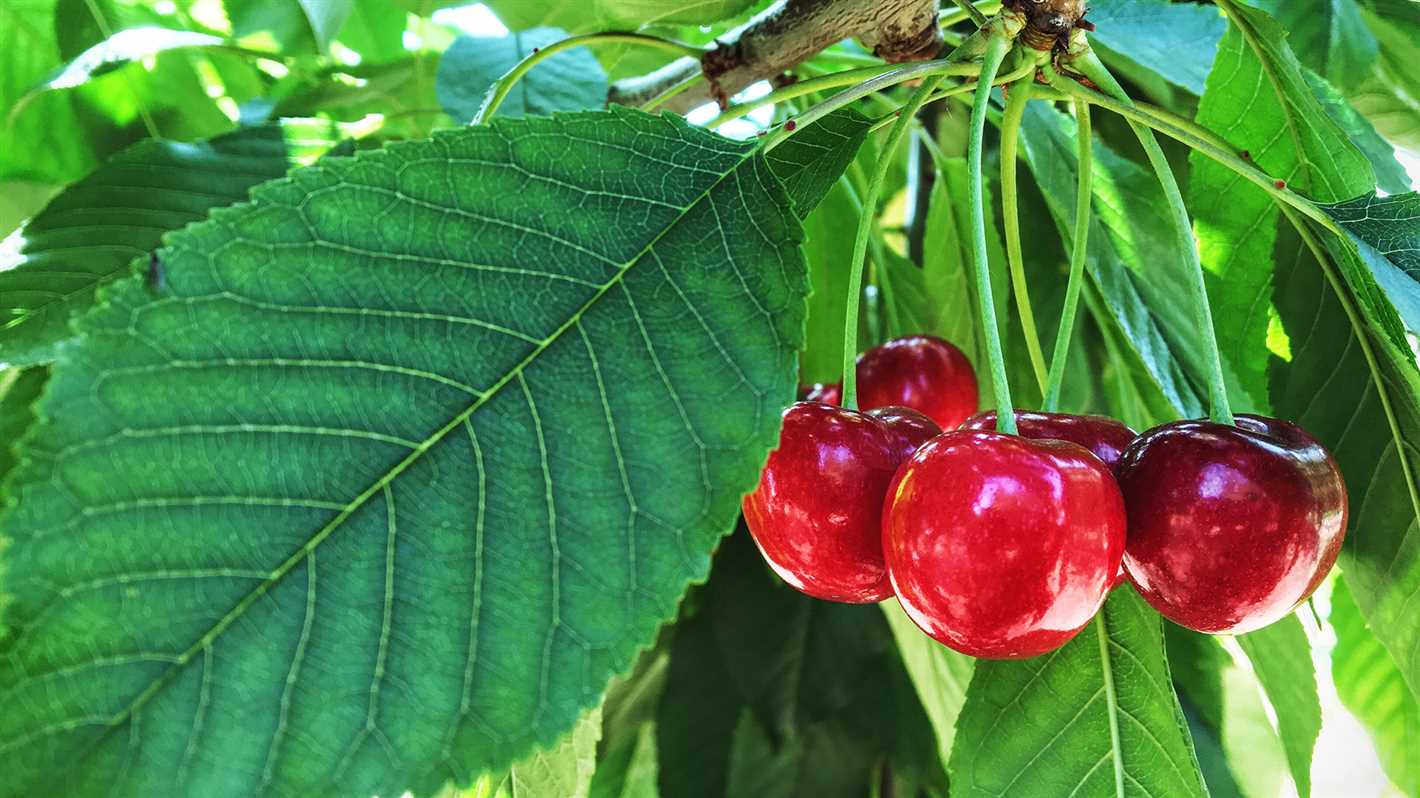
Cherries prefer well-drained soil and full sun, so choose a location in your garden that meets these requirements. It’s best to plant cherry trees in early spring or late fall, when the soil is cool.
Dig a hole that is twice as wide and deep as the root ball of the cherry tree. Place the tree in the hole, making sure that the bud union is level with the soil surface. Fill the hole back in with soil and water thoroughly.
Caring for cherry trees
Proper care is essential for the growth and productivity of cherry trees. Water your cherry tree regularly, especially during dry periods. Apply mulch around the base of the tree to help retain moisture and discourage weed growth.
Pruning is important for cherry trees to maintain their shape and promote fruit production. Prune in late winter or early spring, removing any dead or damaged branches, as well as branches that are crossing or rubbing against each other.
Harvesting and enjoying cherries
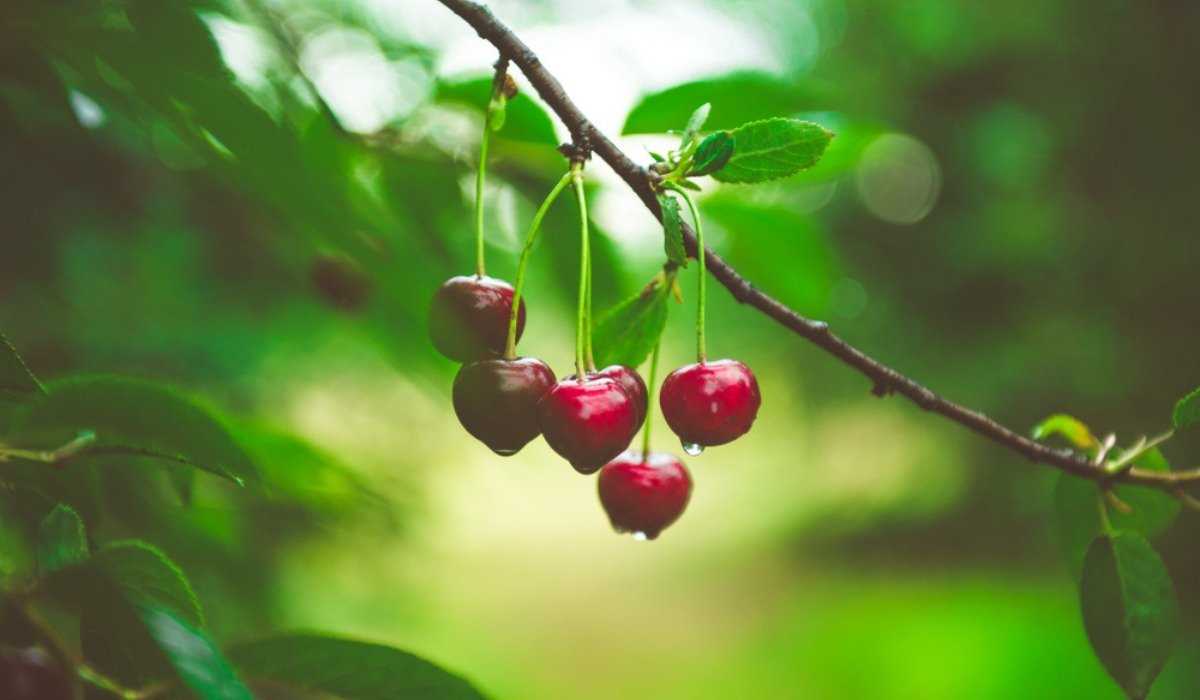
Cherries are ready to be harvested when they are fully ripe and have a deep color. Gently twist the stem of the cherry to harvest it without damaging the tree or the fruit.
Cherries can be enjoyed fresh, used in various recipes such as pies, jams, and syrups, or preserved by freezing or canning. Experiment with different ways of enjoying cherries to find your favorite recipes.
Remember to wash cherries before eating or using them in recipes. Enjoy the delicious taste of fresh cherries!
Growing Cherries in your own garden
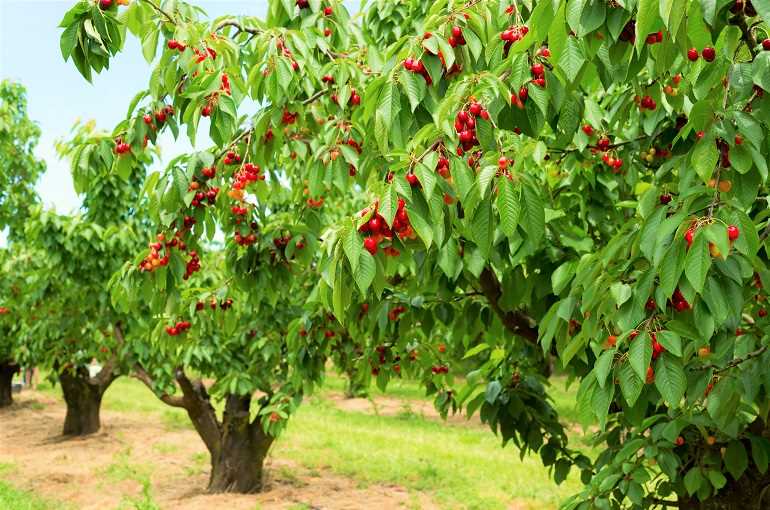
Choose the right variety
When growing cherries in your own garden, it is important to choose the right variety that suits your climate and soil conditions. Some popular cherry varieties include Bing, Rainier, and Stella, among others. Research and consult with local experts to determine the best variety for your specific location.
Prepare the soil
Cherries thrive in well-drained soil with a pH between 6.0 and 7.0. Before planting, make sure to amend the soil with organic matter such as compost or well-rotted manure to improve its fertility and drainage. Remove any weeds or grass from the planting area to avoid competition with the cherry tree.
Planting
Cherry trees are usually planted in late winter or early spring, when the soil is workable. Dig a hole that is wide and deep enough to accommodate the tree’s root system. Place the tree in the hole and backfill it with soil, firming it gently around the roots. Water the tree thoroughly after planting.
Provide proper care
- Watering: Cherries need regular watering, especially during dry periods. Deep watering once a week is usually sufficient.
- Fertilizing: Apply a balanced fertilizer in early spring and again in early summer to provide the tree with the necessary nutrients.
- Pruning: Prune your cherry tree in late winter to remove dead or diseased branches and to shape the tree for better air circulation and sunlight penetration.
- Pest and disease control: Monitor your cherry tree regularly for pests and diseases, and take appropriate measures to control them. Common pests include aphids, fruit flies, and birds.
Harvesting

Cherries are typically ready for harvest in late spring or early summer, depending on the variety and climate. They are ripe when they are fully colored, firm, and have a sweet scent. Gently twist or cut the cherries from the stem to avoid damaging the tree.
Enjoying your homegrown cherries
Once harvested, cherries can be eaten fresh, used in various culinary creations like smoothies, pies, and jams, or preserved by freezing or canning. Nothing beats the taste of freshly picked cherries from your own garden!
| Tip 1: | Protect your cherry tree from strong winds by planting it near a windbreak or using windbreak netting. |
| Tip 2: | Consider using bird netting to protect your cherries from birds, who love to feast on them. |
| Tip 3: | Prune your cherry tree annually to maintain its shape and promote healthy growth. |
| Tip 4: | If you don’t have enough space for a full-sized cherry tree, consider growing a dwarf or semi-dwarf variety. |
The properties of Cherries
1. Nutritional Value
- Cherries are rich in vitamins A and C, as well as potassium and fiber.
- They also contain antioxidants, such as anthocyanins, which can help reduce inflammation and prevent oxidative stress.
- Cherries are low in calories and fat, making them a healthy snack option.
2. Health Benefits
- Consuming cherries may help improve sleep quality and reduce insomnia due to their natural melatonin content.
- Anthocyanins found in cherries have been shown to have anti-inflammatory effects, which may help reduce the risk of chronic diseases.
- Cherries are also known to have anti-cancer properties and may help prevent the growth of cancer cells.
- Regular consumption of cherries has been linked to reduced muscle soreness and improved exercise recovery.
3. Varieties
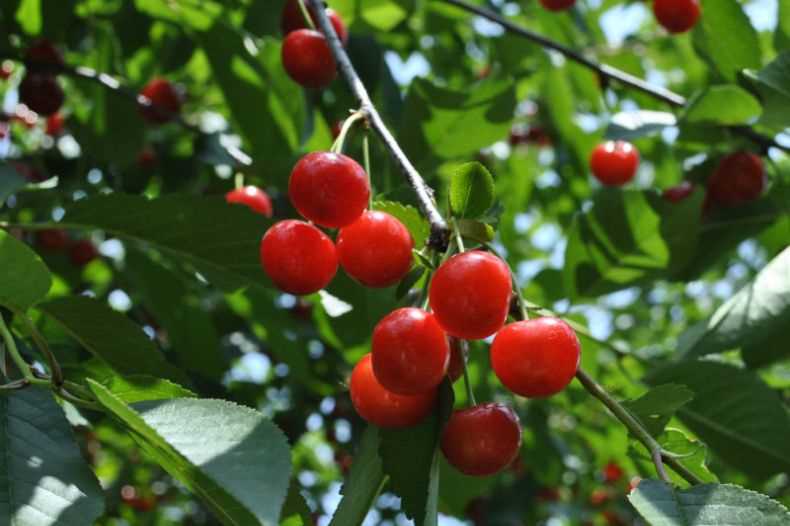
There are several varieties of cherries, including:
- Sweet cherries – these are the most common type of cherry and are typically consumed fresh.
- Sour cherries – these cherries are more tart and are often used in baking and cooking.
- Bing cherries – these are large, sweet cherries with a dark red skin.
- Montmorency cherries – these cherries are sour and are commonly used in cherry pies and preserves.
4. Culinary Uses
Cherries can be enjoyed in various ways, including:
- Eating them fresh as a snack.
- Using them in desserts, such as pies, tarts, and cobblers.
- Adding them to salads for a burst of sweetness.
- Using them in sauces and marinades for savory dishes.
5. Availability
Cherries are typically in season during the summer months, with the peak harvest period varying depending on the region.
They can be found fresh in grocery stores and farmers markets, as well as frozen or dried throughout the year.
Different species of Cherries
Cherries are a diverse fruit with different species that vary in taste, appearance, and growing requirements. Here are some of the most common species of cherries:
Sweet Cherries (Prunus avium): Sweet cherries are the most popular type of cherries, known for their juicy and sweet flavor. They come in various colors ranging from yellow to dark red. Some popular varieties include Bing, Rainier, and Lambert.
Sour Cherries (Prunus cerasus): Sour cherries are smaller and more tart than sweet cherries. They are commonly used in baking and making preserves. Montmorency and Morello are two well-known varieties of sour cherries.
Black Cherries (Prunus serotina): Black cherries are native to North America and are commonly found in forests. They have a slightly bitter taste and are often used in culinary dishes or for making cherry liqueur.
Duke Cherries (Prunus x gondouinii ‘Duke’): Duke cherries are a hybrid of sweet and sour cherries. They have a slightly sweet and tangy flavor and are often used for eating fresh or in cooking.
Each species of cherries has its own unique characteristics and uses. Whether you prefer the sweetness of sweet cherries or the tanginess of sour cherries, there is a cherry species for everyone to enjoy.
Tips for growing healthy Cherries
Growing cherries in your garden can be a rewarding experience. Follow these tips to ensure your cherry trees grow healthy and productive:
1. Choose the right variety
Select cherry tree varieties that are suitable for your climate zone and soil conditions. Some popular varieties include Bing, Rainier, and Montmorency.
2. Provide adequate sunlight
Cherry trees need at least 6-8 hours of direct sunlight daily. Ensure that the planting location receives enough sunlight throughout the day.
3. Plant in well-draining soil
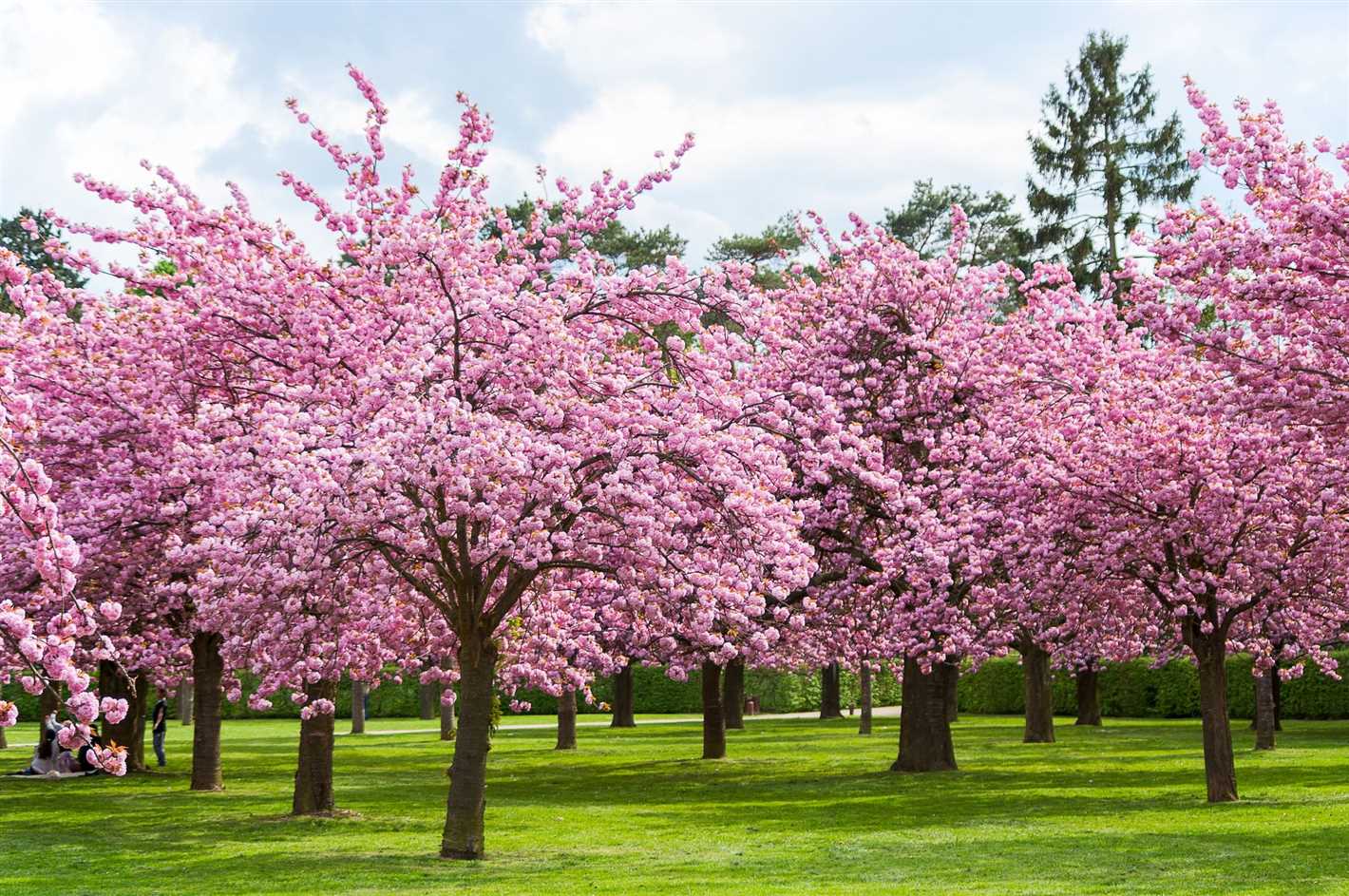
Cherries prefer well-draining soil to prevent root rot. Make sure the soil is loamy and has good drainage. Avoid heavy clay soils that can hold excess water.
4. Water regularly
Water your cherry trees regularly, especially during dry spells. Aim to provide about 1-2 inches of water per week, ensuring the soil remains consistently moist but not waterlogged.
5. Prune and train the trees
Regular pruning helps maintain the shape of the trees and improves air circulation, reducing the risk of diseases. Train the branches to an open center shape, allowing sunlight to reach all parts of the tree.
6. Apply mulch
Apply a layer of organic mulch around the base of the cherry trees to retain moisture, suppress weed growth, and regulate soil temperature.
7. Fertilize as needed
Cherries generally benefit from annual fertilizer applications. Apply a balanced, slow-release fertilizer in early spring to promote healthy growth and fruit production.
8. Protect from pests and diseases
Monitor your cherry trees for common pests such as aphids and cherry fruit flies. Use organic pest control methods or consult with a professional if necessary. Watch out for signs of diseases such as brown rot and implement preventive measures.
9. Harvest at the right time
Wait until the cherries are fully ripe before harvesting. Cherries should be plump, firm, and have a deep color. Harvest by gently twisting the stem or using pruning shears.
10. Enjoy your harvest
Once harvested, cherries can be enjoyed fresh, used in desserts, or preserved for later use. Share the fruits of your labor with friends and family!
Harvesting and storing Cherries
Harvesting cherries is a critical step in ensuring their freshness and taste. Here are some tips to help you harvest and store your cherries:
1. Harvesting cherries:
- Cherries are usually ready for harvest in late spring or early summer, depending on the variety and local climate.
- To check if the cherries are ripe, gently squeeze a few of them. Ripe cherries should be firm and have a slight give.
- When harvesting cherries, use a pair of scissors or pruning shears to cut the stems about 1 inch above the fruit.
- Place the harvested cherries in a shallow container or basket to avoid crushing them.
2. Storing cherries:
- Cherries are best stored in the refrigerator to maintain their freshness and extend their shelf life.
- Before storing, sort the cherries and remove any damaged or bruised ones to prevent them from spoiling the rest.
- Do not wash the cherries before refrigerating them, as excess moisture can lead to mold growth.
- Store the cherries in a perforated plastic bag or in a breathable container that allows airflow.
- Cherries can be stored in the refrigerator for up to one week.
3. Freezing cherries:
If you have an abundant harvest of cherries, freezing them is a great way to preserve their freshness for a longer period. Here’s how to freeze cherries:
- Wash and pit the cherries.
- Spread the cherries in a single layer on a baking sheet lined with parchment paper.
- Place the baking sheet in the freezer for a few hours until the cherries are frozen.
- Transfer the frozen cherries to airtight freezer bags or containers.
- Label the bags or containers with the date and store them in the freezer.
- Frozen cherries can be stored for up to six months.
By following these tips for harvesting and storing cherries, you can enjoy their delicious taste even after the harvest season is over.
Health benefits of Cherries
Cherries are not only delicious but also packed with numerous health benefits. Here are some of the benefits of incorporating cherries into your diet:
- Rich in antioxidants: Cherries are loaded with antioxidants, which help protect the body against harmful free radicals and reduce inflammation.
- Anti-inflammatory properties: The antioxidants and phytochemicals present in cherries have anti-inflammatory effects, which can help alleviate symptoms of inflammatory conditions such as arthritis and gout.
- Improved sleep quality: Cherries are a natural source of melatonin, a hormone that regulates sleep-wake cycles. Consuming cherries or tart cherry juice may help improve sleep quality and duration.
- Reduced risk of heart disease: Cherries contain anthocyanins, a type of antioxidant that has been linked to a lower risk of heart disease by reducing cholesterol levels and preventing the formation of plaques in the arteries.
- Supports brain health: Anthocyanins in cherries have been found to improve cognitive function and protect brain cells from oxidative stress, potentially reducing the risk of age-related neurological diseases.
- Anti-cancer properties: Some studies suggest that the compounds found in cherries may have anticancer effects, inhibiting the growth of tumor cells and reducing the risk of certain types of cancer.
- Improved exercise recovery: Cherries’ anti-inflammatory properties may aid in exercise recovery by reducing muscle soreness and inflammation post-workout.
- Weight management: Cherries are low in calories and high in fiber, making them a satiating and nutritious snack for those aiming to manage their weight.
These are just a few of the many health benefits that cherries offer. Whether enjoyed fresh, dried, or in the form of juice, cherries can be a delicious and nutritious addition to your diet.
Recipes to enjoy Cherries
1. Cherry Smoothie
Ingredients:
- 1 cup cherries, pitted
- 1 banana
- 1 cup almond milk
- 1 tablespoon honey
Instructions:
- Place all the ingredients in a blender.
- Blend until smooth and creamy.
- Pour into glasses and serve chilled.
2. Cherry Salad
Ingredients:
- 2 cups cherries, pitted and halved
- 4 cups mixed salad greens
- 1/2 cup crumbled feta cheese
- 1/4 cup chopped walnuts
- 2 tablespoons balsamic vinegar
- 2 tablespoons olive oil
- 1 tablespoon honey
Instructions:
- In a large bowl, combine the cherries, salad greens, feta cheese, and walnuts.
- In a small bowl, whisk together the balsamic vinegar, olive oil, and honey.
- Pour the dressing over the salad and toss to combine.
- Serve immediately and enjoy.
3. Cherry Pie
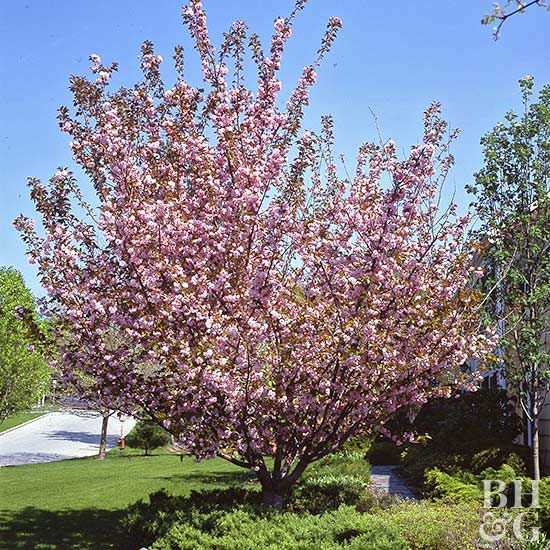
Ingredients:
- 2 cups cherries, pitted
- 1 cup granulated sugar
- 3 tablespoons cornstarch
- 1/4 teaspoon almond extract
- 1/4 teaspoon cinnamon
- 1 package prepared pie crust
Instructions:
- Preheat oven to 425°F (220°C).
- In a large bowl, combine the cherries, sugar, cornstarch, almond extract, and cinnamon.
- Roll out one pie crust and place it in a pie dish.
- Pour the cherry mixture into the crust.
- Roll out the second pie crust and place it on top of the cherry filling.
- Press the edges of the crusts together to seal.
- Make slits in the top crust to allow steam to escape.
- Bake in the preheated oven for 45 minutes or until the crust is golden brown and the filling is bubbly.
- Allow the pie to cool before serving.
4. Cherry Jam
Ingredients:
- 4 cups cherries, pitted and halved
- 2 cups granulated sugar
- 1/4 cup lemon juice
Instructions:
- In a large pot, combine the cherries, sugar, and lemon juice.
- Bring the mixture to a boil over medium-high heat, stirring occasionally.
- Reduce the heat to low and simmer for about 45 minutes, stirring frequently.
- Remove from heat and let cool.
- Transfer the jam to sterilized jars and seal tightly.
- Refrigerate for up to 2 months.
5. Chocolate-Covered Cherries
Ingredients:
- 1 cup cherries, pitted
- 1 cup chocolate chips
- 1 tablespoon coconut oil
Instructions:
- Melt the chocolate chips and coconut oil in a microwave-safe bowl.
- Dip each cherry into the melted chocolate, making sure it is completely coated.
- Place the chocolate-covered cherries on a parchment-lined baking sheet.
- Refrigerate for about 30 minutes or until the chocolate is set.
- Remove from the refrigerator and enjoy.
Question-answer:
What are some popular cherry species for growing in a garden?
Some popular cherry species for growing in a garden include sweet cherry (Prunus avium), tart or sour cherry (Prunus cerasus), and Duke cherry (Prunus x gondouinii).
What are the ideal growing conditions for cherry trees?
Cherry trees thrive in full sun and well-draining soil. They prefer a cool climate with moderate temperatures and a chilling period in winter. They are also sensitive to extreme heat and drought.
How long does it take for a cherry tree to bear fruit?
The time it takes for a cherry tree to bear fruit varies depending on the species and growing conditions. In general, sweet cherry trees can take 3-5 years to bear fruit, while tart cherry trees may start producing fruit within 2-4 years.
What are some common pests and diseases that can affect cherry trees?
Some common pests that can affect cherry trees include cherry fruit fly, birds, and aphids. Cherry trees are also susceptible to diseases such as cherry leaf spot, brown rot, and bacterial canker.
How do you harvest cherries and when is the best time to do so?
Cherries can be harvested by gently twisting them off the tree or by cutting the stem with pruning shears. The best time to harvest cherries depends on the species and desired ripeness. Sweet cherries are typically harvested when they are fully ripe and firm, while tart cherries can be harvested when they are still slightly underripe.







